|
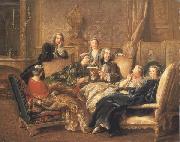 |
Jean Francois de troy
|
|
French Neoclassical Painter, 1679-1752
was a French Rococo painter and tapestry designer. He was one of a family of painters, being the son of the portrait painter François de Troy (1645-1730), under whom he first studied, and at whose expense he went to Italy 1699-1706, staying in Rome, but also visiting many north Italian cities. Jean François de Troy was born on January 27, 1679 in Paris. The successful career of Jean François de Troy was based initially on large historical and allegorical compositions, such as Time Unveiling Truth (1733) in the National Gallery, London, but he is now most highly regarded for his smaller and more spirited scenes of elegant social life. They are among the best of those that rode on the wave of Watteau's success indeed The Alarm, or the Gouvernante Fidele (Victoria and Albert Museum, London, 1723) was attributed to Watteau in the 19th century. A versatile artist, he made tableaux de modes famous, painting histories and mythologies in a colourful and fluent manner which owed something to both Veronese and Peter Paul Rubens. He undertook commissions for Versailles and Fontainebleau between 1724 and 1737, and designed two sets of tapestries for the Gobelins, each of seven subjects, the Histoire d'Esther (1737-40) and the Histoire de Jason (1743-6). |
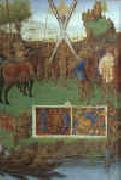 |
Jean Fouquet
|
|
French
1420-1479
Jean Fouquet Locations
French painter and illuminator. He is regarded as the most important French painter of the 15th century and was responsible for introducing Italian Renaissance elements into French painting. Little is known of his life, and, apart from a signed self-portrait medallion (Paris, Louvre), his only authenticated work is the Antiquit?s judaeques (Paris, Bib. N., MS. fr. 247). A corpus of works by Fouquet has therefore been established on the basis of stylistic criteria, but its exact chronology is uncertain. |
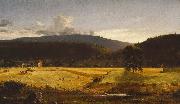 |
Jasper Francis Cropsey
|
|
(February 18, 1823 - April 23, 1900) was an important American landscape artist of the Hudson River School.
Cropsey was born on his father Jacob Rezeau Cropsey's farm in Rossville on Staten Island, New York, the oldest of eight children. As a young boy, Cropsey had recurring periods of poor health. While absent from school, Cropsey taught himself to draw. His early drawings included architectural sketches and landscapes drawn on notepads and in the margins of his schoolbooks.
Trained as an architect, he set up his own office in 1843. Cropsey studied watercolor and life drawing at the National Academy of Design under the instruction of Edward Maury and first exhibited there in 1844. A year later he was elected an associate member and turned exclusively to landscape painting; shortly after he was featured in an exhibition entitled "Italian Compositions."
Cropsey married Maria Cooley in May 1847, traveled in Europe from 1847-1849, visiting England, France, Switzerland, and Italy. He was elected a full member of the Academy in 1851. Cropsey was a personal friend of Henry Tappan, the president of the University of Michigan from 1852 to 1863. At Tappan's invitation, he traveled to Ann Arbor in 1855 and produced two paintings, one of the Detroit Observatory, and a landscape of the campus. He went abroad again in 1855, and resided seven years in London, sending his pictures to the Royal Academy and to the International exhibition of 1862.
Returning home, he opened a studio in New York and specialized in autumnal landscape paintings of the northeastern United States, often idealized and with vivid colors. Cropsey co-founded, with ten fellow artists, the American Society of Painters in Water Colors in 1866. He resided in the City until 1885, when he removed to Hastings-on-Hudson.
The monument of Jasper Francis Cropsey in Sleepy Hollow CemeteryCropsey's home and studio, Ever Rest, in Hastings-on-Hudson, New York as well as the largest permanent collection of Cropsey's work are open for tours by the Newington-Cropsey Foundation.
Jasper Cropsey died in anonymity but was rediscovered by galleries and collectors in the 1960s. Today, Cropsey's paintings are found in most major American museums, including the National Gallery of Art, the Metropolitan Museum of Art, the Los Angeles County Museum of Art, the Detroit Institute of Arts, the Timken Museum of Art in San Diego, the Honolulu Academy of Arts, the Fine Arts Museums of San Francisco, the Denver Art Museum, and the Museum of Fine Arts, Boston. Works by Cropsey also hang in the White House. |
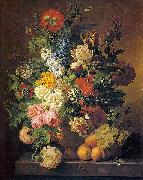 |
Jan Frans van Dael
|
|
an excellent painter of fruit and flowers, was born at Antwerp in 1764, but went early to Paris and settled there. He was self-inatructed in art, but made such progress that he soon distinguished himself at the exhibitions, on one occasion obtaining the prize of 4000 francs, and on two others, the large gold medal. His style is in the manner of Van Huysum and Van Spaendonck, although he did not confine himself strictly to fruit and flowers, but painted other subjects, in which such objects might with propriety be introduced. Two of his pictures, which he painted for the Empress Josephine, represent 'An Offering to Flora,' and 'The Tomb of Julia'; the latter is now in the Louvre. His master-piece, known as 'La Croisee,' the fruit of three years' labour, was likewise purchased by the Empress Josephine, and is now in a private collection at Liege. He was also patronized by the Empress Marie Louise, who took one of his pictures with her to Parma. He died in Paris in 1840, and was buried in the cemetery of Pere Lachaise by the side of his friend Van Spaendonck. The Louvre has also by him three pictures of 'Flowers' and one of 'Fruit.' |
 |
Jan Fyt
|
|
1611-1661
Flemish Jan Fyt Gallery
Flemish painter, draughtsman and etcher.
He was apprenticed in Antwerp in 1621-2 to Hans van den Berch [Berghe] (not to be confused with Jan van den Bergh of Alkmaar) and probably completed his training with Frans Snyders. In 1629-30 Fyt became a master in the Antwerp Guild of St Luke, but he continued to work for Snyders until 1631. In 1633 and 1634 he was in Paris. According to his biographers, he then went to Italy; an Italian journey is confirmed by the fact that in 1650 he joined the Antwerp Guild of Romanists (exclusive to those who had visited Rome), of which he became the dean in 1652. He apparently worked in Rome, where he joined the Schildersbent and was given the nickname Goudvink (Dut.: goldfinch). In Venice, according to Orlandi, Fyt worked for the Sagredo and Contarini families. He is also thought to have visited Naples, Florence and Genoa, and Orlandi stated that he also went to Spain and London. By 5 September 1641 Fyt was back in Antwerp, where, apart from a brief trip to the northern Netherlands in 1642, he apparently remained for the rest of his career. However, Jan-Erasmus Quellinus stated that he again travelled to Italy in the 1650s, a claim supported to some extent by the mention in 1671 of a Self-portrait (untraced) supposedly painted some 20 years earlier in Venice (see 1977 exh. cat.). |
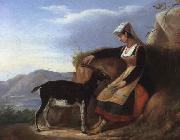 |
Jacques-Francois Ochard
|
|
was a French artist, remembered as the first art teacher of Claude Monet at his high school.
Ochard had been a student of Jacques-Louis David (1748-1825), and lived in Normandy, to where Monet's family had moved in 1845. Ochard's method of instruction was the traditional one of drawing from plaster casts of the human figure.
|
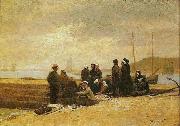 |
Jacques-Eugene Feyen
|
|
(1815, in Bey-sur-Seille, Meurthe-et-Moselle - 1908) was a French painter.
The elder brother of painter Auguste Feyen-Perrin, Jacques-Eugene enrolled at the Ecole des Beaux-Arts and studied under Paul Delaroche. He had a notable career at the Paris Salon from 1841 to 1882. Vincent Van Gogh was a fan of Feyen and describes him as, "one of the few painters who pictures intimate modern life as it really is, and does not turn it into fashion plates." He set up studio and settled in summer in the town of Cancale.He spent several months every year painting views of Cancale, the oyster-picking Cancalaises and the bay of Mont St. Michel, and his paintings still enjoy a steady fame.
|
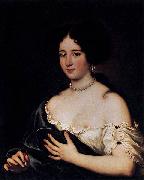 |
Jacob Ferdinand Voet
|
|
(c. 1639 - c. 1689/1700) was a Flemish Baroque portrait painter.
According to the Netherlands Institute for Art History (RKD) he was born at Antwerp as the son of the painter Elias Voet.[1] He travelled to Rome in 1679-1680, Milan in 1680, Florence in 1681, Turin in 1682-1684, and returned to Antwerp in 1684. While in Rome he lived with the painter-engraver Cornelis Bloemaert until he was banned for his portraits of women portrayed with unseemly decollet, whereupon they left Rome together. He undertook a journey to Paris in 1686 where he became court painter until he died there.He is registered as a painter of miniature portraits.
According to Houbraken, he made his return journey to Antwerp from Turin in the company of Jan van Bunnik, who he had already met in Rome in the company of Cornelis Bloemaert. From Turin they set out for Lyons, where they met Adriaen van der Cabel, Peter van Bloemen, and Gillis Wenix. They set off for Paris in the company of a third painter who was a good painter of "bataljes" or battle scenes. Houbraken reports that this was Jacob, Jan van Bunnik's brother, but had not mentioned him earlier in his Jan van Bunnik biography. The RKD makes no mention of a Jacob van Bunnik. |
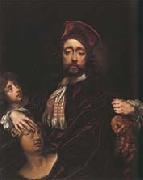 |
Isaac Fuller
|
|
c.1606--72
English painter. He was renowned in his day for large historical, mythological and biblical subjects but was also a very able portrait painter. According to Vertue, he studied under Fran?ois Perrier in France c. 1630, and in 1644 he is documented as working in Oxford, at the same time as William Dobson. There he painted altarpieces, including a Resurrection for All Souls College (a wild imitation of Michelangelo, which John Evelyn considered 'too full of nakeds for a chapel'), a Last Judgement for Magdalen College and a Last Supper for Wadham College. None of these works is known to survive. He also copied Dobson's Beheading of John the Baptist, substituting the heads with portraits of his friends. On moving to London, Fuller worked on decorative schemes for churches, taverns and private houses and continued to paint portraits. In 1654 he published a drawing book, Un libro di disegnare, with 15 etched plates, but there are no known copies. Much of his decorative work was destroyed in the Great Fire in 1666, including that in the Painters' Hall and St Mary Abchurch. Vertue admired his erotic life-size Bacchic figures in the Mitre Tavern in Fenchurch Street. Five crudely painted canvases commemorating the Adventures of Charles II after the Battle of Worcester in 1651 (London, N.P.G.) are his only surviving decorative works. Fuller's reputation as a painter rests mainly on three variants of a Rembrandtesque Self-portrait (1670; Oxford, Bodleian Lib.; Oxford, Queen's Coll |
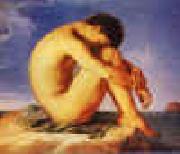 |
Hippolyte Flandrin
|
|
1809-1864
Hippolyte Flandrin Location
Painter and lithographer, brother of Auguste Flandrin. He was initially discouraged from fulfilling his early wish to become an artist by Auguste lack of success, but in 1821 the sculptor Denys Foyatier, an old family friend, persuaded both Hippolyte and Paul to train as artists. He introduced them to the sculptor Jean-Francois Legendre-Heral (1796-1851) and the painter Andre Magnin (1794-1823), with whom they worked copying engravings and plaster casts. After Magnin death, Legendre-Heral took the brothers to the animal and landscape painter Jean-Antoine Duclaux (1783-1868). Hippolyte and Paul had both learnt the techniques of lithography from Auguste at an early age, and between the ages of 14 and 19 Hippolyte produced a number of lithographs, which he sold to supplement the family income. Many reflected his passion for military subjects (e.g. Cossacks in a Bivouac, c. 1825; Paris, Bib. N.). In 1826 the two brothers entered the Ecole des Beaux-Arts in Lyon, where Hippolyte studied under Pierre Revoil. Showing a precocious talent, he was soon advised to move to Paris, and having left the Ecole des Beaux-Arts in Lyon in 1829, he walked to the capital with his brother Paul; together they enrolled in the studio of Ingres. After several unsuccessful attempts, Hippolyte won the Grand Prix de Rome in 1832 with Theseus Recognized by his Father (1832; Paris, Ecole N. Sup. B.-A.), despite having suffered from cholera during the competition. His success was all the more spectacular given the general hostility to Ingres; Hippolyte was the first of his pupils to be awarded this prestigious prize. Hippolyte arrived in Rome in 1833; Paul joined him there in 1834. After first working on such subjects as Virgil and Dante in Hell (1836; Lyon, Mus. B.-A.), Hippolyte developed a taste for religious works during this stay. From 1836 to 1837 he worked on St Clare Healing the Blind for the cathedral in Nantes, winning a first-class medal at the 1837 Salon, and in 1838 he painted Christ Blessing the Children (Lisieux, Mus. Vieux-Lisieux), which was exhibited at the 1839 Salon. |
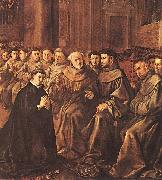 |
HERRERA, Francisco de, the Elder
|
|
Spanish painter (b. ca. 1590, Sevilla, d.
1656, Madrid).
Spanish painter. His early works are in the Mannerist style. Under the influence of Francisco Zurbaron, he developed the naturalistic style seen in his four scenes from the life of St. Bonaventure (1627). About 1650 he moved to Madrid. His last documented work, a painting of St. Joseph (1648) influenced by Anthony Van Dyck, features elongated forms and elaborate draperies. He achieved considerable fame in Sevilla, where Diego Velezquez was briefly his pupil. |
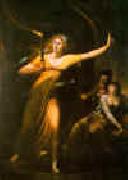 |
Henry Fuseli
|
|
Swiss-born British Romantic Painter, 1741-1825
Henry Fuseli was the first artist to command the epic literature and heroic history of northern Europe as well as the Mediterranean countries, and by his wide reading and close study of the Old Masters he equipped himself to extend the scope of history painting far beyond the traditional limits of the Bible and classical antiquity. In his speculative boldness he was a child of the Enlightenment, but he was also a fierce critic of sterile rationalism and preached the gospel of the imagination with religious fervor.
Henry Fuseli was born Johann Heinrich F??ssli (in 1764 he Anglicized his name) in Zurich on Feb. 6, 1741, the son of a painter with strong religious convictions who destined him for the Zwinglian ministry. After a period of intensive theological study Fuseli was ordained in 1761 and preached his first sermon. He was a friend of Johann Kaspar Lavater, whose Aphorisms on Man he later translated into English from manuscript. Fuseli became the favorite disciple of Johann Jakob Bodmer, who in 1740 had published an essay on the wonderful in poetry that led to a literary war with Johann Christoph Gottsched in Germany and the formation of a revolutionary Swiss school which used English literature, especially Milton and Shakespeare, as a spearhead in promoting romanticism. |
 |
Henri Felix Emmanuel Philippoteaux
|
|
(1815-1884) was a French artist. He was born in Paris, France, studied art at the studio of Leon Cogniet,and first exhibited his work at the Paris Salon of 1833.
One of his most well-known works was a depiction of the Siege of Paris during the Franco-Prussian War, painted in the form of a cyclorama, a type of large panoramic painting on the inside of a cylindrical platform designed to provide a viewer standing in the middle of the cylinder with a view of the painting. Viewers surrounded by the panoramic image are meant to feel as if they are standing in the midst of a historic event or famous place.
Philippoteaux also produced a large number of works chronicling the rise and successes of Napoleon Bonaparte, including a portrait of Napoleon in his regimental uniform and a group of paintings of French victories in the Napoleonic Wars. Philippoteaux was awarded the Legion d'honneur in 1846.
Philippoteaux's son Paul Philippoteaux was also an artist; both were famous for their production of cycloramas. Father and son collaborated on The Defence of the Fort d'Issy in 1871. |
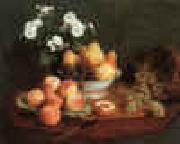 |
Henri Fantin-Latour
|
|
French 1836-1904
Henri Fantin Latour Locations
Bure) French painter and printmaker. He was trained by his father, a portrait painter, and at the Ecole des Beaux-Arts. Though he associated with progressive artists (Gustave Courbet, Eugene Delacroix, Edouard Manet), he was a traditionalist best known for his portraits and still lifes with flowers. His portrait groups, reminiscent of 17th-century Dutch guild portraits, depict literary and artistic persons of the time; his flower paintings were especially popular in England, thanks to James McNeill Whistler and John Everett Millais, who found patrons to support him. His later years were devoted to lithography. |
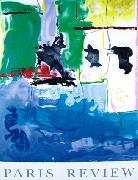 |
Helen Frankenthaler Prints
|
|
Born 1928
Helen Frankenthaler (born December 12, 1928) is an American post-painterly abstraction artist. Born in New York City, she was influenced by Jackson Pollock's paintings and by Clement Greenberg. She was the youngest daughter of a justice on the New York State Supreme Court. She studied at the Dalton School under Rufino Tamayo and also at Bennington College in Vermont. She later married fellow artist Robert Motherwell. |
 |
Heinrich Foelix
|
|
painted Kurfurst Clemens Wenzeslaus von Sachsen in ca. 1776 |
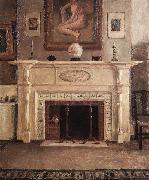 |
Hamilton Easter Field
|
|
(1873-1922) was an important American artist, teacher, author, critic, collector and patron of the arts |
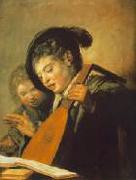 |
HALS, Frans
|
|
Dutch painter (b. 1580, Antwerpen, d. 1666, Haarlem). |
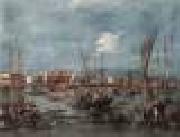 |
GUARDI, Francesco
|
|
Italian Rococo Era Painter, 1712-ca.1793
The records of his parish in Venice show that Francesco Guardi was baptized on Oct. 5, 1712. His father, Domenico, who died when Francesco was 4, had a workshop. Francesco and his elder brother, Gian Antonio, worked in a small studio, carrying out such orders as they could get for almost anything the client wanted:mythological pictures, genre, flower pieces, battle scenes, altarpieces, and even, on rare occasions, frescoes. They did not hesitate to copy compositions by other artists, but what they borrowed they always transformed into something more capricious, less stable, more fragmentary in the refraction of light. Francesco did not emerge as an independent personality until 1760, when his brother died. Then, 48 years old, he married, established his own studio, and devoted himself chiefly to painting views of Venice. For the most part he worked in obscurity, ignored by his contemporaries. He was not even admitted to the Venetian Academy until he was 72 years old. Guardi and Canaletto have always been compared to one another because the buildings they chose to paint were often the same. But the way each artist painted them is very different. Canaletto's world is constructed out of line. It provides solid, carefully drawn, three-dimensional objects that exist within logically constructed three-dimensional space. Guardi's world is constructed out of color and light. The objects in it become weightless in the light's shimmer and dissolve in a welter of brushstrokes; the space, like the forms in space, is suggested rather than described. Canaletto belonged essentially to the Renaissance tradition that began with Giotto and, as it grew progressively tighter and more controlled, pointed the way to neoclassicism. Guardi belonged to the new baroque tradition that grew out of the late style of Titian and, as it became progressively looser and freer, pointed the way toward impressionism. Such differences appear even in Guardi's early view paintings, where he was obviously trying to copy Canaletto, such as the Basin of San Marco. The famous buildings are there, but they are far in the background, insubstantial, seeming to float. In front is a fleet of fishing boats, their curving spars seeming to dance across the surface of the canvas. What is important for Guardi is not perspective but the changing clouds and the way the light falls on the lagoon. Guardi became increasingly fascinated by the water that surrounds Venice. In late works, such as the famous Lagoon with Gondola, buildings and people have been stripped away until there is nothing but the suggestion of a thin line of distant wharfs, a few strokes to indicate one man on a gondola, a long unbroken stretch of still water, and a cloudless sky. Guardi also painted the festivals that so delighted visitors to the city, such as the Marriage of Venice to the Sea. This was a symbolic ceremony in which the doge, in the great gilded galley of the head of state, surrounded by a thousand gondolas, appeared before all Venice, in Goethe's image, "raised up like the Host in a monstrance." Of all Guardi's paintings the most evocative are his caprices, the landscapes born out of his imagination though suggested by the ruined buildings on the lonely islands of the Venetian lagoon. A gentle melancholy clings to such scenes.
|
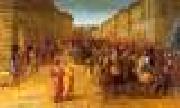 |
GRANACCI, Francesco
|
|
Italian High Renaissance Painter, ca.1469-1543
was an Italian painter of the Renaissance. Born at Villamagna di Volterra, he trained in Florence in the studio of Domenico Ghirlandaio, and was employed painting frescoes for San Marco on commission of Lorenzo de'Medici. He is featured in Giorgio Vasari's Vite. His early works, such as the Enthroned Madonna between Saint Michael and John the Baptist (Staatliche Museen, Berlin), Adoration of the Child (Honolulu Academy of Arts) and four histories of Saint John the Baptist, were influenced by the style of Filippino Lippi. In 1508, Granacci went to Rome, where he and other artists helped his lifelong friend Michelangelo to transfer cartoons to the Sistine chapel ceiling. Returning to Florence, Granacci painted a Madonna with Child with Saints Francesco and Jerome for the Augustinian convent of San Gallo (now in the Gallery of the Academy), a Madonna della Cintola for the Company of San Benedetto Bigi, and in 1515 he participated in creating the decorations to celebrate the visit to Florence of Pope Leo X. In 1519, he painted a Madonna with Child and Saint John. Works of the years 1520-1525 betray a direct influence of Fra Bartolomeo, including a Madonna in throne between Saints Sebastiano and Francesco for Castelfiorentino and a Sacred Conversation for Montemurlo. An altarpiece of the Assumption is influenced by Pietro Perugino. |
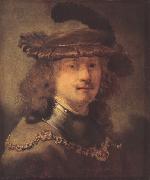 |
Govert flinck
|
|
Dutch Baroque Era Painter, 1615-1660
was a Dutch painter of the Dutch Golden Age. Born at Cleves, he was apprenticed by his father to a silk mercer, but having secretly acquired a passion for drawing, was sent to Leeuwarden, where he boarded in the house of Lambert Jacobszon, a Mennonite, better known as an itinerant preacher than as a painter. Here Flinck was joined by Jacob Backer, and the companionship of a youth determined like himself to be an artist only confirmed his passion for painting. Amongst the neighbours of Jacobszon at Leeuwarden were the sons and relations of Rombertus van Uylenburgh, whose daughter Saske married Rembrandt in 1634. Other members of the same family lived at Amsterdam, cultivating the arts either professionally or as amateurs. The pupils of Lambert probably gained some knowledge of Rembrandt by intercourse with the Ulenburgs. Certainly Joachim von Sandrart, who visited Holland in 1637, found Flinck acknowledged as one of Rembrandt's best pupils, and living habitually in the house of the dealer Hendrik Uylenburg at Amsterdam. For many years Flinck laboured on the lines of Rembrandt, following that master's style in all the works which he executed between 1636 and 1648. With aspirations as a history painter, however, he looked to the swelling forms and grand action of Peter Paul Rubens, which led to many commissions for official and diplomatic painting. Flinck's relations with Cleves became in time very important. He was introduced to the court of the Great Elector, Friedrich Wilhelm I of Brandenburg, who married in 1646 Louisa of Orange. He obtained the patronage of John Maurice of Nassau, who was made stadtholder of Cleves in 1649. In 1652 a citizen of Amsterdam, Flinck married in 1656 an heiress, daughter of Ver Hoeven, a director of the Dutch East India Company. |
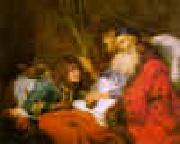 |
Govaert Flinck
|
|
1615-1660
Dutch
Govaert Flinck Locations
Born at Cleves, he was apprenticed by his father to a silk mercer, but having secretly acquired a passion for drawing, was sent to Leeuwarden, where he boarded in the house of Lambert Jacobszon, a Mennonite, better known as an itinerant preacher than as a painter.
Here Flinck was joined by Jacob Backer, and the companionship of a youth determined like himself to be an artist only confirmed his passion for painting. Amongst the neighbours of Jacobszon at Leeuwarden were the sons and relations of Rombertus van Uylenburgh, whose daughter Saske married Rembrandt in 1634. Other members of the same family lived at Amsterdam, cultivating the arts either professionally or as amateurs. The pupils of Lambert probably gained some knowledge of Rembrandt by intercourse with the Ulenburgs. Certainly Joachim von Sandrart, who visited Holland in 1637, found Flinck acknowledged as one of Rembrandt best pupils, and living habitually in the house of the dealer Hendrik Uylenburg at Amsterdam.
For many years Flinck laboured on the lines of Rembrandt, following that master style in all the works which he executed between 1636 and 1648. With aspirations as a history painter, however, he looked to the swelling forms and grand action of Peter Paul Rubens, which led to many commissions for official and diplomatic painting. Flinck relations with Cleves became in time very important. He was introduced to the court of the Great Elector, Friedrich Wilhelm I of Brandenburg, who married in 1646 Louisa of Orange. He obtained the patronage of John Maurice of Nassau, who was made stadtholder of Cleves in 1649. In 1652 a citizen of Amsterdam, Flinck married in 1656 an heiress, daughter of Ver Hoeven, a director of the Dutch East India Company. He was already well-known even then in the patrician circles over which the burgomasters De Graef and the Echevin Six presided; he was on terms of intimacy with the poet Vondel and the treasurer Uitenbogaard. In his house, adorned with antique casts, costumes, and a noble collection of prints, he often received the stadtholder John Maurice, whose portrait is still preserved in the work of the learned Barleius. |
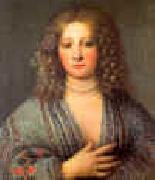 |
Girolamo Forabosco
|
|
1604-1679
Italian
Girolamo Forabosco Location
Italian painter. He was active in Padua and Venice, where he was enrolled in the Fraglia dei Pittori between 1634 and 1639 and paid taxes from 1640 to 1644. His early work, such as the portrait of the so-called Menichina (1624; Rome, Pal. Barberini), was influenced by that of Alessandro Varotari (Padovanino), who had revived the style of Titian. He also adopted compositional and formal schemes from Tiberio Tinelli, as in the Portrait of a Woman. The large canvas of the Miraculous Rescue (1646; Malamocco, S Maria Assunta), commissioned by Giovanni Ventura as an ex-voto for his escape from a shipwreck, shows Forabosco, unconstrained by the narrative and devotional character premises of the undertaking, creating a tender portrait group, distinguished by its spontaneity. The most striking quality of his work is its combination of physiognomic exactitude with free, fluid brushwork. |
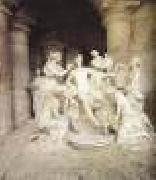 |
GIRARDON, Francois
|
|
French Baroque Era Sculptor, 1628-1715
François Girardon was born at Troyes on March 17, 1628. He studied in Rome for an undetermined period of time between 1645 and 1650. He then studied at the Royal Academy in Paris and was admitted to the academy as a member in 1657. Much of Girardon's most important work was executed for King Louis XIV and consisted of major commissions for the palace and gardens of Versailles. One of Girardon's most famous productions is Apollo and the Nymphs of Thetis in Versailles (1666-1672), originally designed for a grotto there. This elaborate project of seven separate marble statues depicts the god Apollo surrounded by nymphs, and it exemplifies with exceptional clarity the French interpretation of the baroque style in sculpture, an interpretation that rejected the fluid, dramatic, and emotional Italian baroque in favor of a cooler, more sober approach based upon the sculpture of antiquity. The Apollo group is filled with references to Hellenistic and Roman sculpture, and while Girardon was working on the commission he made a second trip to Rome for inspiration from antique sources. The ancient world, however, had never attempted to assemble several large pieces of free-standing sculpture into one unified composition, and in solving this problem Girardon had recourse to the paintings of Nicolas Poussin, the great French baroque classicist. The classicism of the Apollo group conformed fully to the official style of the French Academy and the personal taste of Louis XIV, but the composition has many baroque elements. The vigor and variety in the movement of the figures, the rich textural contrasts, the grand scale of the project, and the dramatic use of space are all stylistic qualities that firmly link the work to the international baroque style. One of Girardon's most important works is the tomb of Cardinal Richelieu in the church of the Sorbonne, Paris (1675-1677). This monument shows the dying prelate in a semireclining position, his vestments falling in broad curves that are echoed in the draperies of the allegorical figures at the head and foot of the tomb. As originally placed in the church, the monument was freestanding so that the spectator was compelled to enter into the action of the work - a typical baroque compositional device. Girardon's most significant late work was a majestic bronze equestrian statue of Louis XIV (1683-1692) executed for the Place Vendôme in Paris and based upon the famous Roman equestrian monument of the emperor Marcus Aurelius. |
 |
Giovanni Fattori
|
|
Italian Realist Painter , 1825-1908
was an Italian artist, one of the leaders of the group known as the Macchiaioli. He was initially a painter of historical themes and military subjects. In his middle years, inspired by the Barbizon school, he became one of the leading Italian plein-airists, painting landscapes, rural scenes, and scenes of military life. After 1884, he devoted much energy to etching. |
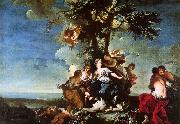 |
Giovanni Domenico Ferretti
|
|
1692-1768 Italian Giovanni Domenico Ferretti Location Italian painter. He was the son of the goldsmith Antonio di Giovanni da Imola and Margherita di Domenico Gori. His mother family, which included her brother, the antiquarian ANTONIO FRANCESCO GORI, was extremely influential in Florence and proved very important for Ferretti. In the first years of his life he lived in Imola, where he was sent to study (1708) with the local painter Francesco Chiusuri. After the family moved to Florence, Ferretti was taught there by Tommaso Redi and Sebastiano Galeotti. Later he spent five years in Bologna, an important centre for the practice and teaching of academic painting, where, in the workshop of Felice Torelli, his work acquired its characteristic style. |
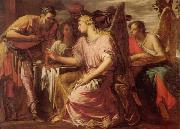 |
Giovanni Antonio Fumiani
|
|
(1645-1710) was an Italian painter of the Baroque period.
Born in Venice in 1645, he trained in Bologna under Domenico degli Ambrogi, a specialist in quadratura, but by 1668 he was back in Venice, where he painted a Virgin and Saints in San Benedetto. He was influenced by Ludovico Carracci and Alessandro Tiarini, and soon also became interested in the work of Paolo Veronese, so that he started to use elaborate architectural settings and brighter colours. He painted a Virgin Appearing to Pius V (1674; Vicenza, S Lorenzo), whose monumentality foreshadows Tiepolo, whereas mosaics in San Marco, created in 1677 from Fumianies cartoons, are closer to the idiosyncratic art of Pietro della Vecchia. He contributed to the decoration of San Rocco (1675, 1676, 1678), where he painted a large canvas of the Charity of St Roch on the ceiling of the nave, In his smaller paintings, however, such as the modelli (Florence, Uffizi) painted for the Ferdinand de Medici, Grand Prince of Tuscany, for whom he worked for a long time, with Niccole Cassana acting as intermediary, Fumiani revealed a lively decorative sense and a taste for animated, sensual subjects that produced works of great quality. His last work is the large lunette depicting Frederick III visiting St Zacharyes Convent in the Company of the Doge (Venice, San Zaccaria).
The decoration of San Pantalon with scenes from the Life of St Pantaleon (1680-1704) utilized canvases to cover a large ceiling (25x50 m), an ambitious undertaking, both in its scale and in the unity of the magniloquent images, that parallels Andrea Pozzoes decoration at the church of Sant'Ignazio in Rome. Fumiani was responsible for painting what is claimed to the largest painting on canvas in the world and covers the whole of the ceiling of the church Chiesa di San Pantaleone Martire, known as San Pantalon, in Venice. The painting depicts The Martyrdom and Apotheosis of St Pantalon, which he painted from 1680 until 1704. He putatively died from a fall from a scaffold, although some sources date his death to six years after he stopped work on the canvas
|
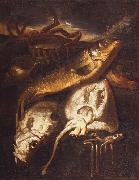 |
Giacomo Francesco Cipper
|
|
(Feldkirch, 1664 - Milan, 1736) was a German painter active in Milan from 1696 to 1736.
Of German origin, he was active in Milan in the first half of the 18th century. Fertile painter of scenes of kind of formulation caravaggesca, his first attributed work is dated 1700; he operated in Lombardia and in Veneto ( Hunters and greengrocers , Modena, Gallery Campori; Farmers' family , Venice, Galleries of the academy). Subsequently the artist, perhaps under the influence of the Cerruti (some of whose works were once attributed to Cipper), to the scrupulous surrender of the detail it replaced a less illustrative vision, more sensitive to the games of light.
His last known work is Self-portrait (1736, Hampton Court).
|
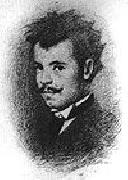 |
Giacomo Favretto
|
|
Abbandonata la bottega di falegname paterna, frequenti dal 1864 l'Accademia di Belle Arti di Venezia, dove le lezioni impartitegli misero in luce le qualita innate di pittore, evidenziate in una delle sue opere maggiori La lezione di anatomia (1873).
Nel 1878 compi un viaggio a Parigi insieme a Guglielmo Ciardi. Il viaggio fu determinante per l'evoluzione della sua arte, come tecnica e come soggetti (non solo scene di intimita familiare ma anche soggetti in costume settecentesco). Riscosse un ottimo successo, si fece conoscere a livello internazionale e assimilo una certa tendenza al manierismo.
Del 1880 e l'opera Vandalismo, premiata a Brera, dove fu esposta ed e attualmente conservata. In queste opere l'artista si converti verso un'animazione realistica, un uso della coloristica controllato, un grande dispiego inventivo e una delicatezza tonale.
Negli ultimi anni le opere del Favretto assunsero una sempre crescente luminosita ed una struttura sempre piu naturalistica.
Mori nel 1887, durante l'Esposizione nazionale artistica tenutasi nella citta lagunare, nella quale l'artista esponeva Il Liston. |
 |
Georges de Feure
|
|
1868-1928
French designer and painter. Son of a Dutch architect and a Belgian mother, he started out as an actor, costumier and then interior decorator in Paris. In 1894 at the Galerie des Artistes Modernes he exhibited watercolours and paintings of a moderate Symbolist style, typically depicting women in a manner reminiscent of Aubrey Beardsley work. Capturing the essence of the feminine spirit became his trademark. With Eugene Gaillard and Edouard Colonna he was selected by Siegfried Bing, founder of the Galeries de l Art Nouveau, to design rooms for his Pavilion Bing at the Exposition Universelle, Paris (1900). De Feure carpets, glassware and furniture designs for the boudoir and toilette were based on the theme of woman, emphasizing delicate lines and elegant sensuality. He later left Bing gallery and, as an independent designer, created vide-poche furniture, which contained hidden marquetry compartments. This furniture suggested notions of secrecy and coquetry, themes that de Feure pursued throughout his career. |
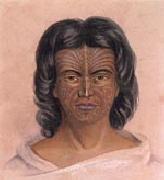 |
George French Angas
|
|
(1844-1932), was a portrait painter.
was an English explorer, naturalist and painter. He was the eldest son of George Fife Angas, prominent in the establishment of the new colony of South Australia. Despite showing remarkable talent in drawing, he was placed in a London business house by his father. He left on a tour of Europe and in 1842 published his first book, "Rambles in Malta and Sicily". As a result of this experience, he turned his back on the world of commerce, and directed his training towards a study of natural history, anatomical drawing and lithography. Embarking on his travels, he was soon to find his acquired skills extremely useful. Angas painted some of the earliest views of South Australia. Arriving in Adelaide in January 1844, he joined Sir George Grey on an expedition into the interior. He soon began an extensive series of journeys to the Murray River lakes, Barossa Valley, Fleurieu Peninsula and the South East, presenting his impressions of the newly established colony ?C its inhabitants, landscape, and its flora and fauna. Following a trip to New Zealand he returned to South Australia in 1845 and travelled to Port Lincoln. In the following year he returned for a short while to England. His next journey in 1846 was to South Africa, where he spent two years in Natal and the Cape, working on a series of drawings and watercolours which were published in 1849 as The Kafirs Illustrated. In this book were views of Cape Town, Durban, Wynberg, Genadendal, Paarl and Somerset West and plates depicting the local ethnic groups such as Hottentots, Malays and Zulus. He married Alicia Mary Moran in 1849, the marriage producing four daughters. In 1853 he was appointed to a position at the Australian Museum in Sydney, eventually becoming Director and staying a total of seven years. He was in Sydney when gold was first discovered near Bathurst, New South Wales. Travelling there to record the gold diggings he executed a number of drawings of the scenes that he found. These were published in Sydney and subsequently in London. Angas returned to South Australia in 1860, and finally went back to England in 1863. |
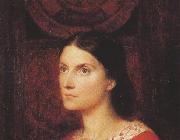 |
George Frederick watts,O.M.,R.A.
|
|
1817-1904
English painter and sculptor. He studied at the Royal Academy and in Italy, where he developed an enthusiasm for Renaissance painting and Greek sculpture that greatly influenced his work. He executed several decorative commissions, including his large fresco Justice (Lincoln's Inn, London), modeled after Raphael's School of Athens. Many of his allegorical pictures are in the Tate Gallery, London. The National Portrait Gallery, London, contains a large collection of his portraits of eminent contemporaries. The Metropolitan Museum has his Ariadne in Naxos. |
|

